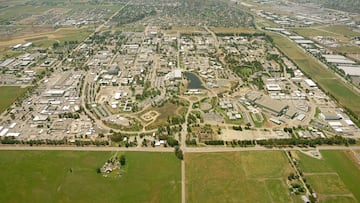Nuclear fusion explained: What is it and why is it so difficult to achieve?
Nuclear fusion has been only a decade away for several, reproducing the source of energy that powers the Sun here on Earth has been a challenge.

The search for clean limitless energy has been going on for decades. Nuclear fission it was thought would provide so much cheap clean energy that meters would no longer be necessary. However, the radioactive waste, a handful of accidents and nuclear weapons have turned many against splitting atoms to provide electricity.
Follow here the live announcement of Jennifer Granholm, the US Secretary of Energy.
Since at least the 1930s though, scientists have also been working on nuclear fusion. The US government has been funding research into harnessing the power of the Sun here on Earth since the 1950s. It currently pumps around $700 million annually into the endeavor.
That investment may finally have paid off. The Financial Times reported that scientists at the Lawrence Livermore National Laboratory in California have made a major breakthrough. For the first time they have achieved a significant net energy gain from the experimental fusion reactor located at the facility.
What is nuclear fussion and why is it so difficult to achieve?
Generating the energy that powers the Sun is no easy feat. Our star is a massive ball of primarily hydrogen, for now, that because of gravity pushes in on itself compacting and heating the gas. The pressure is so intense that it raises the temperature to 27 million degrees Fahrenheit (15 million degrees Celsius).
This turns the gas into a plasma where the nuclei of two lighter atoms of hydrogen fuse together to produce a heavier atom of helium and at the same time release vast amounts of energy. This will continue until the hydrogen has been used up whereupon the Sun will begin to fuse helium atoms together.
Here on Earth, scientists are researching different ways to imitate what the Sun does. Two main techniques are being used. The ITER experimental fusion reactor being built in France will be the world’s largest tokamak reactor, which uses powerful magnetic fields to confine the plasma in a doughnut shape. In order to get the atoms of deuterium and tritium, heavy hydrogen, to fuse and release energy they will need to be heated them to 270 million degrees Fahrenheit.
It was supposed to produce its first full fusion reaction by 2023, but that has been pushed back to 2035. ITER project managers hope to do the first plasma test in December 2025.
In the case of the experimental fusion reactor at Lawrence Livermore National Laboratory in California, multiple lasers are used. Almost 200 in fact, that measure the size of three football fields, that bombard a tiny pellet of heavy hydrogen made up of deuterium and tritium to initiate the fusion reaction.
In order for the process to be commercially viable, the energy that is produced by the fusion reaction needs to be around 100 times bigger than what is put in. Citing people with knowledge of the matter, researchers at the facility managed to produce a net energy gain of 120 percent, although the results were preliminary.
More testing will need to be done before fusion reactors could replace other forms of producing electricity. And while the saying that we are just a decade away from nuclear fusion is still valid, this time it may actually be on the mark. Well at least maybe for a couple more.






